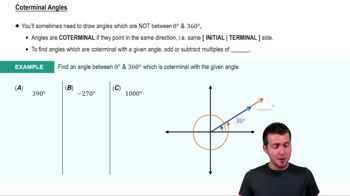Table of contents
- 0. Review of College Algebra4h 43m
- 1. Measuring Angles39m
- 2. Trigonometric Functions on Right Triangles2h 5m
- 3. Unit Circle1h 19m
- 4. Graphing Trigonometric Functions1h 19m
- 5. Inverse Trigonometric Functions and Basic Trigonometric Equations1h 41m
- 6. Trigonometric Identities and More Equations2h 34m
- 7. Non-Right Triangles1h 38m
- 8. Vectors2h 25m
- 9. Polar Equations2h 5m
- 10. Parametric Equations1h 6m
- 11. Graphing Complex Numbers1h 7m
1. Measuring Angles
Complementary and Supplementary Angles
Problem 3.53
Textbook Question
Convert each degree measure to radians. If applicable, round to the nearest thousandth. See Example 1(c).
56° 25'
 Verified step by step guidance
Verified step by step guidance1
Convert the degree measure to a decimal by recognizing that 25' (minutes) is a fraction of a degree. Since there are 60 minutes in a degree, convert 25' to degrees by dividing by 60: \( 25' = \frac{25}{60} \) degrees.
Add the converted minutes to the degree measure: \( 56° + \frac{25}{60}° \).
Calculate the total degree measure as a decimal.
Use the conversion factor from degrees to radians: \( \text{radians} = \text{degrees} \times \frac{\pi}{180} \).
Multiply the total degree measure by \( \frac{\pi}{180} \) to convert it to radians.
Recommended similar problem, with video answer:
 Verified Solution
Verified SolutionThis video solution was recommended by our tutors as helpful for the problem above
Video duration:
0m:0sPlay a video:
Was this helpful?
Key Concepts
Here are the essential concepts you must grasp in order to answer the question correctly.
Degree to Radian Conversion
To convert degrees to radians, use the formula: radians = degrees × (π/180). This relationship stems from the definition of a radian, which is the angle subtended at the center of a circle by an arc equal in length to the radius. Understanding this conversion is essential for solving problems that require angle measurements in different units.
Recommended video:

Converting between Degrees & Radians
Understanding Minutes in Angles
In angle measurement, degrees can be subdivided into minutes and seconds, where 1 degree equals 60 minutes and 1 minute equals 60 seconds. This means that when converting angles expressed in degrees and minutes to radians, both components must be converted separately before summing them. Recognizing this subdivision is crucial for accurate conversions.
Recommended video:

Coterminal Angles
Rounding Numbers
Rounding is the process of adjusting a number to a specified degree of accuracy, often to simplify calculations or present results clearly. In this context, rounding to the nearest thousandth means keeping three decimal places in the final answer. Mastery of rounding techniques is important for ensuring that results are both precise and easy to interpret.
Recommended video:

Introduction to Complex Numbers

 3:35m
3:35mWatch next
Master Intro to Complementary & Supplementary Angles with a bite sized video explanation from Patrick Ford
Start learningRelated Videos
Related Practice








